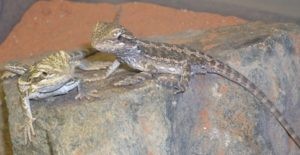When you picture a reptile, you might think of a snake slithering silently or a large lizard basking in the sun. The idea of interacting with these creatures in a loving way, like petting a dog or cat, might seem strange or even impossible. However, many reptile owners believe they share a bond with their scaly companions and that their reptiles enjoy their company. This raises an interesting question: can reptiles feel emotions, and do they actually like being pet?
According to Dr. Sharman Hoppes, a clinical assistant professor at the Texas A&M College of Veterinary Medicine & Biomedical Sciences, reptiles do exhibit basic emotions. While fear and aggression are the most easily recognized, they can also show signs of pleasure, particularly when stroked or offered food. This suggests that the emotional lives of reptiles are more complex than we might initially assume.
Recognizing Reptile Emotions: Beyond Fight or Flight
Understanding reptile emotions starts with recognizing their communication methods. A hissing snake, as Dr. Hoppes points out, is a clear sign of aggression or feeling threatened. This is a warning signal that indicates discomfort and potential danger. Forcing interaction at this point could lead to a defensive strike. Snakes, especially when feeling hostile, may coil their bodies as an additional warning. However, it’s important to remember that most pet snakes, when properly cared for and not provoked, are not inherently aggressive.
Fear in reptiles often manifests as an attempt to escape. However, it can also be confused with aggression because a frightened reptile might also strike out as a defense mechanism. This is why patience is key when introducing yourself to a new reptile pet. Minimize handling initially to allow them to acclimate to your presence and avoid instilling fear that could be misinterpreted as aggression. Short, positive interactions are much more effective than long sessions that could overwhelm or scare your new pet.
The Question of Pleasure and Bonding in Reptiles
The idea of pleasure or even affection in reptiles is more debated. Some argue that these complex emotions are not naturally beneficial for their survival in the wild. Despite this, many reptile keepers observe behaviors that suggest recognition and preference. Many reptiles appear to differentiate between people, especially those who regularly feed and handle them.
Dr. Hoppes notes, “I don’t know if it is love, but lizards and tortoises appear to like some people more than others.” She further elaborates that lizards and tortoises often seem to be the most expressive, with many lizards showing visible signs of pleasure when being gently stroked. This might include relaxing their posture, closing their eyes, or even approaching a familiar hand for interaction.
Interestingly, reptile parental care varies greatly. While many reptiles are solitary and abandon their young after laying eggs, some species exhibit more complex social structures. Prehensile-tailed skinks, for example, live in family groups and protect their offspring. Female alligators are known to stay with their young for extended periods, up to six months, guarding them and even teaching them survival skills through vocalizations. Whether these behaviors stem from instinct or a deeper level of parental care is still a subject of scientific inquiry.
Signs Your Reptile Might Enjoy Interaction
When it comes to interacting with humans, some reptiles do seem to appreciate the attention. A tortoise that enjoys being petted might extend its neck, close its eyes, and become still and relaxed during the interaction. Similar behaviors can be observed in lizards. These can be interpreted as positive responses to gentle touch and handling.
 Baby bearded dragons huddled together, highlighting the range of social behaviors in reptiles from solitary to communal.
Baby bearded dragons huddled together, highlighting the range of social behaviors in reptiles from solitary to communal.
Dr. Hoppes adds, “Some reptiles do appear to enjoy human contact, especially when food is offered.” Many reptiles are quick to learn feeding schedules and will respond to the people they associate with food. Iguanas, in particular, often show clear preferences for certain individuals.
Reptile Personalities and Individual Preferences
It’s crucial to remember that, like all animals, reptiles have individual personalities. Iguanas, for example, can range from calm and docile to aggressive and dominant. While calmer iguanas may form strong bonds with their owners and tolerate handling from them, they may not extend this sociability to strangers. Truly social iguanas who enjoy interaction with a wide range of people are relatively rare.
Ultimately, whether your reptile “likes” being pet is subjective and depends on the individual animal and species. Many reptile owners believe their pets recognize their good intentions and enjoy the interaction. Others believe their reptiles merely tolerate handling when necessary. The key is careful observation. By paying close attention to your reptile’s body language and behavior during handling, you can discern their preferences and tailor your interactions to ensure their comfort and well-being. Understanding reptile emotions and respecting their individual boundaries is essential for responsible reptile ownership and building a positive relationship with your cold-blooded companion.

